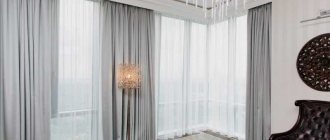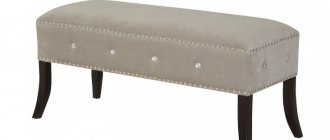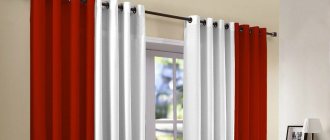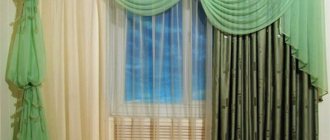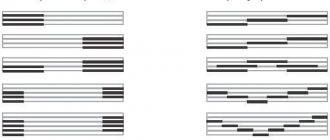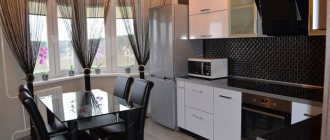Restraint and oriental minimalism quickly gained immense popularity among designers and buyers. In the world of design, the Japanese have long been leaders, offering the market new ideas and technologies. Lovers of exotic home decoration should think about Japanese curtains.
Having chosen this direction, you must take into account that not every interior will fit well with Japanese-style curtains. The most suitable would be minimalism or high-tech style.
Innovation of Japanese curtains
Japanese curtain panels are similar to blinds. These are canvases in separate cassettes. The cord can be used to control the panels. An innovative solution was a remote control for adjusting curtains from a distance.
Curtain panels consist of equal panels that are attached to the cornice. In this way they are similar to vertical blinds, but there is no possibility to rotate the slats. But you can move the whole canvas to the sides to adjust the light or get a better view.
Organza
Such curtains allow you to visually relieve the atmosphere and make it more airy. Their main drawback is low sun protection. But it disappears if you complement the organza panels with canvases of opaque fabric.
In what areas can Japanese panels be used?
If you have avant-garde style furniture in a large room with the same windows, then Japanese window panels are a great option.
The range of their applications is wide; they can be used as partitions (screens) in a room. They can cover a baby’s crib, highlight a wardrobe in the hallway, or divide a room.
In living rooms, brighter colors or a combination of opposites are chosen.
Japanese curtains in the kitchen interior are also an interesting option. Light shades will refresh the small size of the kitchen and visually expand it. The versatility of Japanese curtain panels gives great possibilities and is easy to combine with furniture or flooring. And if they become dirty, they can be replaced.
Material of manufacture
The design of these curtains is the same. However, the material used to sew them may differ. Below are the most popular options.
Types of fabric
It is not difficult to sew such curtains with your own hands; you can choose thick or thin fabrics. Preference should be given to natural materials. Traditionally, cotton fabrics, linen or silk are chosen. Bamboo and woven jute will help bring exoticism into your home.
First, look at examples of photos of Japanese curtains in catalogs to successfully arrange the panels. The Japanese tradition has a peaceful and calm palette of colors. Shades of cream, blue or green are ideal. Oriental laconicism throughout; an original option would be a variety of hieroglyphs or oriental images with vegetation.
A fashionable solution has become to combine several canvases of different colors. For example, white color harmonizes perfectly with colors or patterns. It is recommended to alternate plain and colored panels; a smooth transition from one color to another is possible.
What is the advantage of such curtains?
Let's consider the main advantages of Japanese curtains:
A good choice for a dark room.
- In addition to the fact that Japanese kitchen curtains are beautiful, they are also functional and practical, which is very important when we talk about the kitchen. Thanks to their unusual design, panel curtains collect very little dust, and they practically do not get dirty compared to other types of curtains.
- If the panels do get dirty, they can be easily removed from the frame. You can wash such curtains in a way convenient for you - either manually or in a washing machine.
- Sewing Japanese-style curtains requires a minimal amount of fabric, and the panels can be combined in different ways, using a variety of textures, colors and prints.
- Japanese curtains can be used as an original way to divide the kitchen space, for example, as a screen between the kitchen itself and the dining room. In the photo you can see a good example of this separation.
Making your own curtains
To make Japanese curtains, you need to have sewing skills. First you need to cut out the required number of identical panels. Based on the size of the window, you need to correctly calculate the width of the curtains, since the cornice for Japanese curtains is standard.
Allowances for fabric shrinkage, weights and Velcro are required. The finished panels must be ironed well for perfectly even shapes.
How to choose the right curtain material?
The main thing you need to pay attention to when choosing curtains is the fabric.
Thick black and white curtains in Japanese style.
When sewing, almost all fabrics, both synthetic and natural, can be used. Original curtains made of jute, bamboo and other materials will look advantageous.
Kitchen curtains are often made from linen or cotton; chiffon, viscose, polyester, and organza are also popular. It is necessary that the curtains are wear-resistant: they do not fade and are easy to wash.
Designers advise choosing plain fabrics, and when using patterns, you should give preference to large prints. Checks, images of flowers or fruits, stripes - such designs will never go out of fashion.
Panel management
The curtains can be adjusted with a cord or an automatic remote control. Five-row panels are best controlled with a stylish remote control.
Easy to make and functional, Japanese photo curtains in the interior will add an extraordinary airy atmosphere. This strict elegance of Eastern culture will appeal to many.
Selecting Japanese-style panels for kitchen decoration
There are several criteria that you need to pay attention to when choosing Japanese curtains for the kitchen.
- Length. The more spacious the kitchen space, the longer the curtains can be. In small rooms, it is recommended to limit products to the window sill. It is important to remember about the weights that are located at the bottom of the canvases. They will prevent the fabric from curling and ensure there are no wrinkles.
- Color. The colors of the fabric can be different - from natural calm shades, considered oriental classics, to a bright modern palette. When choosing a suitable range, we must not forget about the laconicism of the images. You should not experiment with contrasts and “poisonous” tones.
- Presence of ornament. On plain, almost transparent fabrics, fine and clear lettering is acceptable. Large flowers look good against a restrained but rich background. When choosing an interesting design, you should not limit yourself to traditional hieroglyphs or dragons - watercolor painting is no less appropriate for oriental motifs.
- Canvas material. It is not necessary to make ensembles from the same type of fabric. You can combine organza with linen, taffeta with thick silk - there are many options. When choosing a material, it is important to consider its functionality and practicality. Loose fabrics will quickly absorb kitchen odors, moisture and grease, losing their attractiveness. For the kitchen, materials with the addition of synthetic fibers are preferable.
Related article: Proper repair of semi-turn valves
We use it in the interior
It would seem that the external simplicity and minimalist design of panel curtains cannot decorate the interior in an original way. However, this is the highlight of these products. If necessary, fabrics can be used in different colors and with different patterns. An unusual option is alternating multi-colored canvases that differ in texture. You can combine fabric decorated with a pattern with a plain fabric. It is also possible to use canvases of different widths.
Panel curtains can be used to divide a room into functional zones. Also, Japanese panels can be used to separate the dressing room from the common room. They are often hung on doorways, loggias, balconies, and kitchens.
Adviсe
For greater comfort, alternate several curtains made of light and dense materials. You can independently sew several options for curtains, different colors and textures, so that you can quickly change the design of the window area if you wish.
Choose the colors and theme of the patterns on Japanese curtains, based on the style in which the rest of the rooms are decorated.
It is necessary to pay attention to the fact that Japanese style does not like mixing with opposing styles. He will be able to shift attention to minimalism, conciseness, calm, originality of design, however, in other options, similar panels will only facilitate the main idea or transfer the entire emphasis to themselves.
Oriental originality is one of those cases when it is better to initially turn to the help of experienced designers than to later spend money and effort on correcting technical errors and aesthetic shortcomings.
Conclusion
Do not forget that Japanese panels are also an excellent means for segmenting space. This is especially appropriate in the kitchen, because with the help of screen curtains you can divide one large kitchen into a dining room and a cooking area.
Related article: Wallpaper for a narrow room
The ease of installation of the systems allows you to carry out all the work yourself. Curtains installed in the kitchen have to be cleaned and washed more often than curtains in other rooms, so it is better not to use special floor curtain rods. Although they provide the most reliable fixation of the panels, they significantly complicate the process of caring for fabric sheets.


